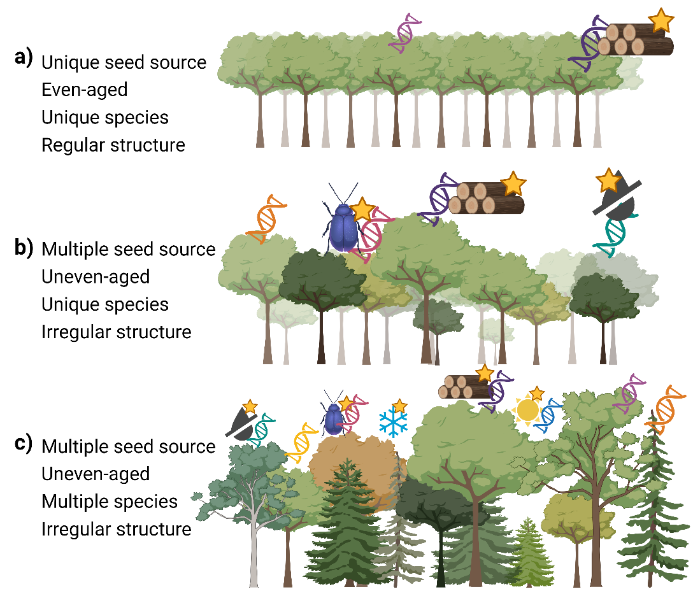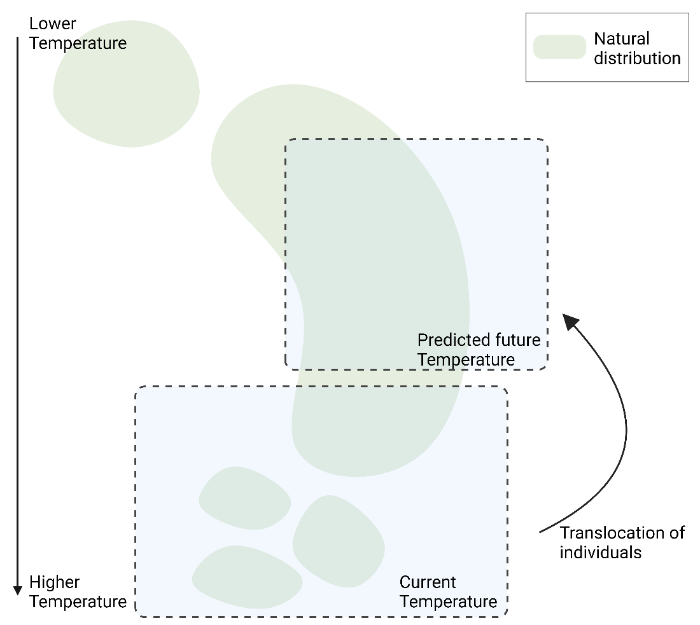01 March 2024
Adapting our forests for climate change – why genetic diversity matters

Laura Guillardín and Niall Farrelly, Teagasc Forestry Development Department, write about the importance of genetic diversity in trees for adapting to the impacts of climate change, through conservation, restoration, and management strategies.
Forests are home to many different plant species, from small annual herbs to large, long-living trees. They also provide niche environments to enhance biodiversity, supporting insects, birds and mammal species and are an important refuge for flora and fauna. Within these forests, the trees play an important role in delivering numerous ecosystem services, they are responsible for CO2 capture and storage from the atmosphere in their biomass assisting in climate change mitigation, they play an important role in maintaining water quality, and enhancing biodiversity at the wider landscape level. Forests also have an associated cultural significance, especially ancient forests and their association with humanity where they have been utilised as a place of refuge and an important source of primary materials. They continue to play an important role for the production of timber, paper, energy and provision of food (fruit, nuts, etc.).
However, climate change is threatening current and future forest habitats. The impact of warmer temperatures is creating conditions which promote more frequent wildfires, longer drought episodes and the proliferation of pests and diseases, trees are ever more being challenged by the changing environment. That is where genetic diversity may play a key role to allow trees and forests to adapt to future uncertainties.
Genetic diversity is the raw material and main mechanism trees have in which to adapt and evolve in response to climate change disturbances. These disturbances can result in negative consequences for natural forests and planted woodlands, therefore, understanding the composition of the forest in terms of its genetic makeup is very important to developing conservation, restoration and management strategies for important ecosystems. An understanding of the genetics of trees allows foresters to identify the strengths and weaknesses in the ecosystem which may become vulnerable to disturbance. Important resilience traits can be found in populations of trees which may enhance their adaption and tolerance to stressors. These can be enhanced by genetic improvement programmes for target traits of importance.
For example, a woodland composed of trees from a unique seed source will have less chance of adapting to new conditions in the long term, due to a narrower gene pool (combination of all the genes and their alternatives present in a reproducing population) from which the population can evolve in response to the stressor (Figure 1, a). A multiple-seed source forest may have a wider gene pool and so, the tree population will hold more variants in its DNA sequences to assemble different genes, therefore, some trees within the population will be able to cope with these stressors (Figure 1, b).
The same idea follows the difference between pure and multiple species woodlands. Some species have already been exposed for a large amount of time (and are adapted) to extreme climate conditions or are hosts to some pests, showing a certain amount of resistance or susceptibility. Therefore, woodlands composed of several species will also increase their total potential to survive disturbances (Figure 1, c). Furthermore, forests that have irregular structures, composed of trees of different sizes, and shapes may confer an advantage over uniform forests and may assist to stop or reduce the speed of wildfires or pest and disease outbreaks as they have trees with varying susceptibility to damaging pests and pathogens.

Figure 1. Genetic diversity differences of even-aged plantation from single seed source (a), uneven-aged from multiple seed sources (b) and uneven-aged multiple species from multiple seed sources (c). Plots modified from Zeng and Fisher (2021).
For all these reasons is important to estimate and monitor the genetic diversity levels of our forests. By using molecular tools to study trees’ DNA, we can estimate how diverse forests are and their potential to tackle environmental challenges. It is possible to increase the genetic diversity of forests by planting trees from target populations that can be added to forests where necessary. For example, the transfer of trees acclimatised to growing in adverse climate conditions populations, from the edges of the natural distribution ranges, is becoming a popular method (called assisted gene flow) to enhance other areas’ genetic diversity (Figure 2). Transfer for trees from southerly locations allows foresters to transfer trees adapted to growing in warmer conditions to northerly locations which are warming, thus future-proofing the forest. This knowledge will be a key strategy to support sustainable forest management plans and ensure high levels of genetic diversity are present in our forests which ensure the resilience of forests over the long term.

Figure 2. Assisted gene flow diagram. The translocation of individuals from areas adapted to higher temperatures to areas that match the predicted climate conditions. Modified from Aitken and Bemmels (2015).
This article is based on research undertaken by Teagasc researchers which is funded by the Department of Agriculture Food and the Marine under the projects: FitForets, Grant number-2019R511 and AdaptForRes, Grant number-2021RI302.
Futher information about the research projects is available at: FitForests and AdaptForREs
References
Aitken, S.N. and Bemmels, J.B. (2016), Time to get moving: assisted gene flow of forest trees. Evol Appl, 9: 271-290. https://doi.org/10.1111/eva.12293
